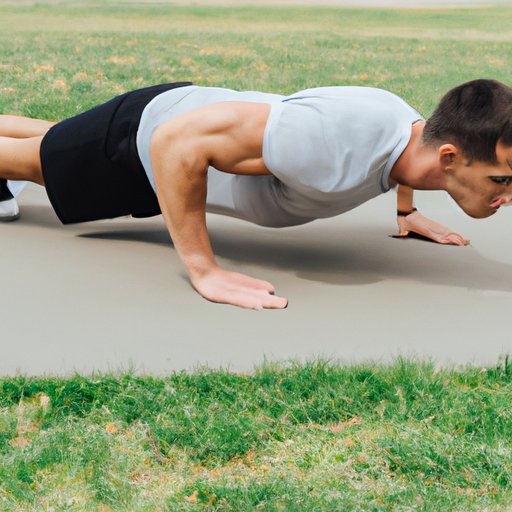
Introduction
Pushups are one of the most popular and effective bodyweight exercises that target the upper body. They not only strengthen your chest, shoulders, and arms but also engage your core and lower body muscles. Whether you are a fitness enthusiast or just starting your fitness journey, pushups are an essential exercise that you should incorporate into your workout routine. In this article, we provide a step-by-step guide to doing pushups with proper form, progressions for beginners, workout routines that include pushups, the benefits of pushups, common mistakes to avoid, and much more.
Step-by-Step Guide
The proper form and posture are essential for doing pushups correctly. The incorrect form or posture can lead to injury or ineffective training. Here is a step-by-step guide on how to do a pushup:
1. Start with a straight plank position with your hands slightly wider than shoulder-width apart, fingers pointing forwards, and toes grounded on the floor.
2. Engage your core, glutes, and leg muscles to maintain a straight line from your head to your heels.
3. Inhale deeply and lower your body until your chest touches the floor or slightly hovers above it. Keep your elbows tight to your sides and pointing back, not flaring out.
4. Exhale forcefully and push back up to the starting position with your arms straight, without locking your elbows.
Repeat this movement for a set number of reps, or until you fatigue.
Beginner’s Guide
If you are just starting or struggle to do standard pushups, there are modified variations that you can do, such as incline pushups, wall pushups, knee pushups, or hand-release pushups. These variations can help you build your upper body strength and gradually progress to standard pushups.
To progress, start with the wall or incline pushups and gradually work your way to knee pushups until you can perform eight reps comfortably. Then, you can start practicing standard pushups by gradually increasing the reps and sets until you can perform three sets of 15-20 reps with excellent form.
When doing the modified or standard pushups, follow these tips to get the most of your workout while preventing injury:
1. Keep your back straight, abs tight, and glutes engaged throughout the movement.
2. Keep your shoulders away from your ears, and your neck in a neutral position.
3. Lower your body slowly and avoid bouncing or shrugging at the bottom.
4. Do not let your lower back sag or hyper-extend your spine.
5. Breathe deeply throughout the movement.
Pushup Workout Routines
Pushups can be part of your full-body workout routine or done separately. The key is to change up your routine and challenge your body to avoid plateauing. Here are some pushup-based workout routines that you can try:
1. Pushup Circuit Training – Alternate pushups with other bodyweight exercises like squats, lunges, planks, or jumping jacks, for a set amount of time or reps.
2. Plyometric Pushups – Perform explosive pushups that require you to push your body off the floor and clap your hands before landing back in the starting position.
3. Combining Pushups – Combine pushups with burpees or mountain climbers to create a full-body, high-intensity workout.
You can set up a routine by performing 2-4 sets of each exercise with 10-15 reps per set. Gradually increase the reps and sets or add more challenging exercises to increase the intensity.
Benefits of Pushups
Pushups are an excellent exercise that benefits your overall health and body strength. Here are some benefits of pushups:
1. Develops Upper Body Strength – Pushups target the pectoral, triceps, and shoulder muscles, helping you develop upper body strength.
2. Engages Core and Lower Body Muscles – Pushups also engage your abs, hip, and leg muscles, improving your overall body stability and coordination.
3. Can Be Done Anywhere – Pushups require no equipment, and you can do them anywhere, anytime, making them convenient to fit into your busy schedule.
4. Time-Efficient – Pushups engage multiple muscle groups simultaneously, making them time-efficient for a full-body workout.
Frequency of Pushup Incorporation
For best results, incorporate pushups in your overall fitness routine, performing two to three sets of 10-20 reps, three times a week, allowing 24 to 48 hours of rest between workouts to prevent muscle fatigue and overuse injury.
Common Mistakes to Avoid
To avoid injuries or ineffective training, here are the common mistakes to avoid when doing pushups:
1. Improper Form – Improper form includes sagging the hips, flaring elbows out, bouncing or collapsing at the bottom, or hyper-extending the spine. These mistakes can lead to injury or ineffective training.
2. Not Engaging the Core and Glutes – When you do not engage your core and leg muscles, you miss out on the full-body benefits of pushups.
3. Overtraining – Overtraining the same muscle group can lead to fatigue, injury, or a plateau in progress.
4. Not Progressing Gradually – Rushing to do the standard pushups without progressing gradually increases the risk of injury.
Conclusion
Pushups are an excellent exercise that targets the upper body, engages the core and leg muscles, and can be done anywhere without equipment. To benefit from pushups, use proper form and posture, follow appropriate progressions, do pushup-based workout routines, and avoid common mistakes. Incorporating pushups into your overall fitness routine two to three times weekly benefits your overall health, strength, and stability. With dedication, practice, and patience, you can master the pushup and enjoy its benefits.




